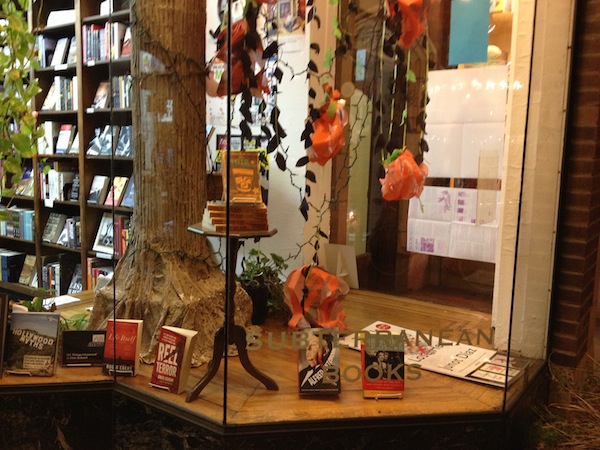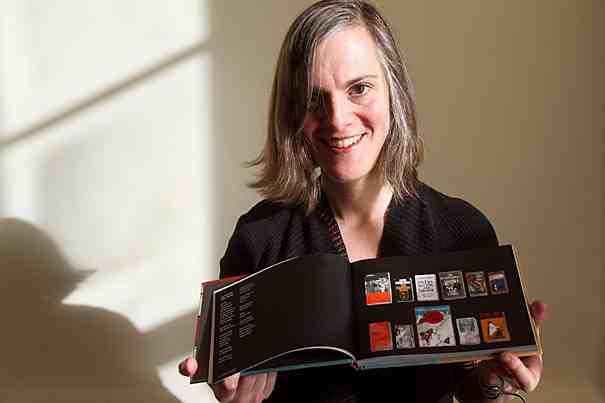Guest post by Aimee Nezhukumatathil
Dear Reader,
As I type this, I can see that the usually quiet streets of my small town are now full and crowded by trucks with mattresses tied to the roofs, the various construction vehicles that peppered campus are slowly disappearing, and our big-box store is filled with harried parents and kids waving around school supply lists and bulk boxes of packaged cookies and juice boxes. After weeks of the hottest summer days I can remember here, today, I actually had to dig up a cardigan to wear when I was in the garden this morning.
What does this all mean? Oh, yes: it’s back to school time.
Now, I
love school supplies (I’ve had the joy of buying them all but 3 of the last 30 years of my life–one for the year I waited tables after college, the second for the semester I was on sabbatical, and now this one, where I am on leave this semester). But there is something about this time of year that makes me want to do the
listening station shuffle of joy. Maybe it is the newness and promise of a blank page. The freshly sharpened pencils or
bouquet of new pens in the blue ball jar on my desk.
Even my college students seem especially eager and ready to learn, dutifully taking notes on just about everything you say those heady and beautiful first weeks of fall semester. Even by the first weeks of spring semester, you can see the malaise and
senioritis sink in early on–or is that just me? I confess I even bought a few single-subject spiral notebooks and stocked up on my favorite composition notebooks (my writing notebook of choice. And
Sylvia’s, too.)
I don’t even want to bother getting into the tired debate regarding the MFA or not-to-MFA if you want to be a writer. I have an MFA, so take from that what you will. For now, I simply want to dive into sharing what was one of the most important things I learned when I was in graduate school (other than how to indulge/satisfy my school supplies addiction on a grad student budget!): how to read.
I mean, of course, I knew how to
read (“And you were not yet three,” I can hear my mother proudly cooing), but I never knew how to read as a
writer. How to mine and interrogate books of poems to learn/deconstruct/construct and most of all–to figure out how to study syntax and the music of a line and to simply stare, open-mouthed at lines that made me feel the way Emily did,
with her head off, so to speak.
It was in grad school that a whole world of reading opened up to me. I felt like I was always playing catch-up with my peers, whom I was convinced every single one of them was better read than me (I was late to the game as an undergrad, having been a chemistry major up until late in my junior year). I wanted to be able to know just who these poets were that were always being referenced in workshop: Berryman, Brooks, Levine, Wright, Clifton, Sexton, Hayden, et al.
And so it goes for me when there is just a slight chill in the air and the morning glories and bee balm are starting to brown and go to seed–I want to immerse myself in books. I have a stack of poetry books released in 2010 that I cannot wait to get my hands on, reading once for pleasure, then again (sorry, can’t help it, the professor in me won’t allow it!) with a pen in hand to scribble in marginalia, or notes to myself, for later. Some of these I hope to teach when I return in January, and some of these are to teach myself.
Right now, the book that I am enjoying immensely during those late-night baby-feedings is not poetry actually, but a “guidebook” of sorts–John McNally’s The Creative Writer’s Survival Guide: Advice from an Unrepentant Novelist. I’m more than halfway done and I know I will be assigning it to my advanced creative writing students on their “suggested reading” list. My copy just arrived last week, but it is already looking used and abused from all the pages I’ve dog-eared. (Caveat: I know John and he is a friend of mine, but even if I didn’t, I still would be drawn to his immediately likeable, yet no-holds barred voice.) There are writerly anecdotes about publishing, promotion, and learning your craft that are so funny, I scared the bejeebus out of my poor Jasper (pictured below) when I laughed out loud–one instance in particular, a description about McNally as a featured reader at a local library gone awry. And anyway, when was the last time you read a book about writing that not only entertained you, but more importantly, made you feel smarter once you put it down? This book is the literary equivalent of a good kick-in-the-pants. And isn’t this the perfect time of the year for a good inspirational (and informative) paperback to tuck into your purse or knapsack?
So, Dear Reader–do YOU get as excited about school supplies as much as I do? With all the great back-to-school sales, what kinds of pens or paper do you buy for the year? I’m especially curious about what books you return to (or have waiting for you on your nightstand) to learn something about the craft of poetry or fiction itself? Please share in the comments section below. I’ll start: I often teach The Triggering Town, by Richard Hugo, and it’s one of those books that I learn something new about poetry every single time I read it.
As for school supplies, today I just bought a 2-pack of glue sticks–for a quarter! When you swipe it across a piece of paper, it looks purple so you can see what you are doing, but it dries clear. Can’t beat that price! I’m not sure what I could possibly need a glue stick for as I make edits on my new manuscript of poems that I just got back from my editors at Tupelo Press, but I am sure they’ll come in handy…at some point this semester. You never know, right? To all of you who are dealing with the upcoming school year in some shape and form (elementary, high school, or college), and to everyone else who plans on making a fresh start in their writing lives in the next few weeks–I wish you the very best as you open your notebooks to that beautiful blank first page. Happy Back to School!
This is Aimee’s seventh post for Get Behind the Plough.


